
If you ask Westend residents what makes their neighbourhood so special, you almost always get the same answer: the people that live here. One of the hotspots for good neighbourliness is the Ladencafé Marais. We asked owner Alexandra Baumann about the special way of life in the area.
Living in Westend is different. Until the 1990s, it was inhabited by ordinary people from the working class. Even today, it is still characterised by industrial charm, narrow alleyways and backyard workshops, as well as spacious cooperative apartments. At the same time, Westend appears as a self-contained area, bordered by railway tracks to the north, west and south and the expansive Theresienwiese (Oktoberfest fairground) to the east. The urban density seems to bring people closer together. In Munich, Westend is known as the district with the strongest neighbourly character, a place where residents spontaneously forge close bonds.
“Everyone knows each other. If something happens, people help each other – that's really nice,” she says.
Alexandra Baumann has been living here for more than 30 years. During this time, she has moved a few times, but only within the neighbourhood. Moving away is not an option for her – and why should she? “I don't actually leave Westend very often. I'm always out and about in the neighbourhood; it's my village,” says Alexandra and laughs. She can only spare a brief moment to talk – there's always too much to do: taking orders, packing jewellery, answering questions, coordinating employees, making espresso macchiatos.
Alexandra is the owner of Ladencafé Marais, one of those places in Westend where you can not only feel the good neighbourly spirit, but also experience it. “Everyone knows each other. If something happens, people help each other – that's really nice,” she says. Alexandra can have her deliveries dropped off at the second-hand shop across the street. In the backyard, there are a restaurant owner and a roofer and if an extra hand is needed in the Ladencafé, they are always there to help. “In return, we're their coffee supplier,” laughs Alexandra as she describes the relationship.
The interior of Café Marais exudes a sense of connection, community spirit and togetherness. At first glance, it looks like a museum, with furnishings from the 1920s, because it is located in a former textile shop. Then it also feels like a flea market, since you can buy vintage furniture, jewellery, clothes, bags and all kinds of little treasures here. And, of course, it is also a café – a place where people meet for breakfast, paninis and homemade cake.
When the former shop was re-let in 2006, Alexandra was living just around the corner. Some of its original features have been retained, including the shop windows and dressmaker's dummies. Today, however, the suits are worn by real people – sitting in the display windows, having breakfast and drinking coffee. Actually, only very few are wearing a suit. “Everyone comes here,” says Alexandra: young couples having an extended brunch, elderly ladies enjoying a quiet cup of coffee, families and friends of all ages. “We also have little guests, who persuade their dads to stop by, because we have the best chocolate croissants,” says Alexandra Another highlight for younger guests: “Paraguas de Chocolate”, small chocolate umbrellas from Spain, lovingly wrapped. Alexandra tells us that they are always a big hit.
On a sunny morning, she is just taking a still-wrapped handbag out of a wooden drawer to hand it over to a customer when a little guest approaches her. “How much does this cost?” a small voice calls from below, holding up a pair of turquoise earrings, with her mother close behind. Alexandra answers the question and leads mother and child to a nearby mirror. “They look different depending on the light,” she says, before disappearing behind the counter again.
A few steps away, two young English-speaking men in flowered shirts are seated, eating from their bread basket and eagerly ordering: “Coffee, please.” At a window seat near the entrance, a couple is enjoying a leisurely breakfast, while a large group of girls toast to life at the tables outside. And, of course, the regulars keep coming to the Ladencafé.
“Most of them are actually from the neighbourhood,” says Alexandra. For example, the older gentleman who was once the apprentice to a notary. One of his first tasks was to track down the heirs of the former textile shop owner. When he stumbled across the café decades later, he recognised the address. “Parkstrasse 2,” he had said to Alexandra, “that was my very first assignment.” He and his wife are now over 70. “But they still come here,” says Alexandra.
A highlight for younger guests: “Paraguas de Chocolate”, small chocolate umbrellas from Spain, lovingly wrapped. Alexandra tells us that they are always a big hit.
At lunchtime, two ladies stand at the till to pay. One of them has a toddler in her arms, curiously peering over her shoulder and making eye contact with a man with a cap, who is also standing in the queue. They smile at each other, the mother notices and smiles back and a conversation is sparked. The man talks about his teenage daughter, then looks at the little one and says nostalgically: “Oh yes, it's been a while for me.” And there it is again: that familiar neighbourly feeling. Even if you are strangers at first, you quickly get to know each other in Westend – especially over good coffee and delicious food.